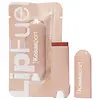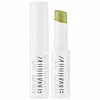What's inside
What's inside
 Key Ingredients
Key Ingredients

 Benefits
Benefits

 Concerns
Concerns

 Ingredients Side-by-side
Ingredients Side-by-side

Ricinus Communis Seed Oil
MaskingCaprylic/Capric Triglyceride
MaskingEuphorbia Cerifera Cera
AstringentBis-Diglyceryl Polyacyladipate-2
EmollientMica
Cosmetic ColorantSilica
AbrasiveOctyldodecanol
EmollientLanolin Oil
EmollientJojoba Esters
EmollientPentaerythrityl Tetraethylhexanoate
EmollientHelianthus Annuus Seed Cera
EmollientBeeswax
Emulsion StabilisingCopernicia Cerifera Wax
Camellia Oleifera Seed Oil
Skin ConditioningTheobroma Cacao Seed Butter
EmollientVitis Vinifera Seed Oil
EmollientAcacia Decurrens Flower Cera
EmollientButyrospermum Parkii Butter
Skin ConditioningCaprylyl Glycol
EmollientCarthamus Tinctorius Seed Oil
MaskingEthylhexyl Palmitate
EmollientEthylhexylglycerin
Skin ConditioningGlucomannan
Skin ConditioningHelianthus Annuus Extract
EmollientMangifera Indica Seed Butter
Skin ConditioningMentha Arvensis Leaf Oil
MaskingOryza Sativa Bran Extract
Skin ConditioningPersea Gratissima Oil
Skin ConditioningPolyglycerin-3
HumectantRosa Canina Fruit Oil
EmollientRosmarinus Officinalis Leaf Extract
AntimicrobialSimmondsia Chinensis Seed Oil
EmollientSodium Hyaluronate
HumectantTocopherol
AntioxidantTocopheryl Acetate
AntioxidantTrihydroxystearin
Skin ConditioningLimonene
PerfumingCI 77891
Cosmetic ColorantCI 15850
Cosmetic ColorantCI 77491
Cosmetic ColorantCI 77492
Cosmetic ColorantCI 77499
Cosmetic ColorantCI 73360
Cosmetic ColorantRicinus Communis Seed Oil, Caprylic/Capric Triglyceride, Euphorbia Cerifera Cera, Bis-Diglyceryl Polyacyladipate-2, Mica, Silica, Octyldodecanol, Lanolin Oil, Jojoba Esters, Pentaerythrityl Tetraethylhexanoate, Helianthus Annuus Seed Cera, Beeswax, Copernicia Cerifera Wax, Camellia Oleifera Seed Oil, Theobroma Cacao Seed Butter, Vitis Vinifera Seed Oil, Acacia Decurrens Flower Cera, Butyrospermum Parkii Butter, Caprylyl Glycol, Carthamus Tinctorius Seed Oil, Ethylhexyl Palmitate, Ethylhexylglycerin, Glucomannan, Helianthus Annuus Extract, Mangifera Indica Seed Butter, Mentha Arvensis Leaf Oil, Oryza Sativa Bran Extract, Persea Gratissima Oil, Polyglycerin-3, Rosa Canina Fruit Oil, Rosmarinus Officinalis Leaf Extract, Simmondsia Chinensis Seed Oil, Sodium Hyaluronate, Tocopherol, Tocopheryl Acetate, Trihydroxystearin, Limonene, CI 77891, CI 15850, CI 77491, CI 77492, CI 77499, CI 73360
Olea Europaea Fruit Oil
MaskingBis-Diglyceryl Polyacyladipate-2
EmollientSilica
AbrasiveSimmondsia Chinensis Seed Oil
EmollientButyrospermum Parkii Butter
Skin ConditioningHydrogenated Polyisobutene
EmollientHelianthus Annuus Seed Wax
Skin ConditioningPhytosteryl/Octyldodecyl Lauroyl Glutamate
Skin ConditioningMango Butter Dimer Dilinoleyl Esters/Dimer Dilinoleate Copolymer
EmollientMoringa Oil/Hydrogenated Moringa Oil Esters
Skin ConditioningPolyglyceryl-10 Pentaisostearate
EmollientCocos Nucifera Oil
MaskingHydrogenated Castor Oil Dimer Dilinoleate
Skin ConditioningCaprylic/Capric Triglyceride
MaskingC10-18 Triglycerides
EmollientLauryl Laurate
Skin ConditioningPolyhydroxystearic Acid
EmulsifyingTribehenin
EmollientHydrogenated Vegetable Oil
EmollientJojoba Esters
EmollientParfum
MaskingMentha Piperita Oil
MaskingTheobroma Cacao Seed Butter
EmollientCannabis Sativa Seed Oil
EmollientCannabis Sativa Seed Extract
EmollientRosmarinus Officinalis Leaf Extract
AntimicrobialStevia Rebaudiana Extract
Acacia Decurrens Flower Wax
EmollientPolyglycerin-3
HumectantTocopheryl Acetate
AntioxidantHelianthus Annuus Seed Oil
EmollientQuercetin
AntioxidantTocopherol
AntioxidantCitral
PerfumingGeraniol
PerfumingLimonene
PerfumingLinalool
PerfumingMica
Cosmetic ColorantCI 77492
Cosmetic ColorantCI 19140
Cosmetic ColorantCI 42090
Cosmetic ColorantOlea Europaea Fruit Oil, Bis-Diglyceryl Polyacyladipate-2, Silica, Simmondsia Chinensis Seed Oil, Butyrospermum Parkii Butter, Hydrogenated Polyisobutene, Helianthus Annuus Seed Wax, Phytosteryl/Octyldodecyl Lauroyl Glutamate, Mango Butter Dimer Dilinoleyl Esters/Dimer Dilinoleate Copolymer, Moringa Oil/Hydrogenated Moringa Oil Esters, Polyglyceryl-10 Pentaisostearate, Cocos Nucifera Oil, Hydrogenated Castor Oil Dimer Dilinoleate, Caprylic/Capric Triglyceride, C10-18 Triglycerides, Lauryl Laurate, Polyhydroxystearic Acid, Tribehenin, Hydrogenated Vegetable Oil, Jojoba Esters, Parfum, Mentha Piperita Oil, Theobroma Cacao Seed Butter, Cannabis Sativa Seed Oil, Cannabis Sativa Seed Extract, Rosmarinus Officinalis Leaf Extract, Stevia Rebaudiana Extract, Acacia Decurrens Flower Wax, Polyglycerin-3, Tocopheryl Acetate, Helianthus Annuus Seed Oil, Quercetin, Tocopherol, Citral, Geraniol, Limonene, Linalool, Mica, CI 77492, CI 19140, CI 42090
 Reviews
Reviews

Ingredients Explained
These ingredients are found in both products.
Ingredients higher up in an ingredient list are typically present in a larger amount.
This ingredient is lipid-based synthetic skin-conditioning agent derived from adipic acid and a mixture of fatty acids. It is often called a lanolin substitute.
As an emollient, it helps soften and hydrate the skin. Emollients create a barrier on the skin to trap moisture in.
Due to its fatty acid base, it may not be Malassezia folliculitis safe.
Learn more about Bis-Diglyceryl Polyacyladipate-2This ingredient is also known as shea butter. It is an effective skin hydrator and emollient.
Emollients help soothe and soften your skin. It does this by creating a protective film on your skin. This barrier helps trap moisture and keeps your skin hydrated. Emollients may be effective at treating dry or itchy skin.
Shea butter is rich in antioxidants. Antioxidants help fight free-radicals, or molecules that may harm the body. It is also full of fatty acids including stearic acid and linoleic acid. These acids help replenish the skin and keep skin moisturized.
While Shea Butter has an SPF rating of about 3-4, it is not a sunscreen replacement.
Shea butter may not be fungal acne safe. We recommend speaking with a professional if you have any concerns.
Learn more about Butyrospermum Parkii ButterThis ingredient is an emollient, solvent, and texture enhancer. It is considered a skin-softener by helping the skin prevent moisture loss.
It helps thicken a product's formula and makes it easier to spread by dissolving clumping compounds.
Caprylic Triglyceride is made by combining glycerin with coconut oil, forming a clear liquid.
While there is an assumption Caprylic Triglyceride can clog pores due to it being derived from coconut oil, there is no research supporting this.
Learn more about Caprylic/Capric TriglycerideCi 77492 is also hydrated iron III oxide. It's sole purpose is to give a yellow hue to products.
Iron III oxides are classified as inorganic chemicals for coloring.
Synthetically created Ci 77492 is considered safer than those naturally found. This is because the synthetically created version may contain less impurities. Iron oxides are generally non-toxic and non-allergenic.
Learn more about CI 77492Jojoba Esters is a wax created from Jojoba oil. It is an emollient and film-forming ingredient. In bead form, it is an exfoliator.
This ingredient has high oxidative stability, meaning it doesn't break down when exposed to oxygen.
Its similarity to our skin's natural oils makes it a great emollient. Emollients help soften and soothe our skin by creating a barrier on top. This barrier helps trap moisture in, keeping skin hydrated.
It is created using either the hydrogenation or transesterification processes on jojoba oil.
Learn more about Jojoba EstersLimonene is a fragrance that adds scent and taste to a formulation.
It's found in the peel oil of citrus fruits and other plants such as lavender and eucalyptus. The scent of limonene is generally described as "sweet citrus".
Limonene acts as an antioxidant, meaning it helps neutralize free radicals.
When exposed to air, oxidized limonene may sensitize the skin. Because of this, limonene is often avoided by people with sensitive skin.
The term 'fragrance' is not regulated in many countries. In many cases, it is up to the brand to define this term. For instance, many brands choose to label themselves as "fragrance-free" because they are not using synthetic fragrances. However, their products may still contain ingredients such as essential oils that are considered a fragrance.
Learn more about LimoneneMica is a naturally occurring mineral used to add shimmer and color in cosmetics. It can also help improve the texture of a product or give it an opaque, white/silver color.
Serecite is the name for very fine but ragged grains of mica.
This ingredient is often coated with metal oxides like titanium dioxide. Trace amounts of heavy metals may be found in mica, but these metals are not harmful in our personal products.
Mica has been used since prehistoric times throughout the world. Ancient Egyptian, Indian, Greek, Roman, Aztec, and Chinese civilizations have used mica.
Learn more about MicaPolyglycerin-3 is a 3-unit glycerin polymer.
Like glycerin, this ingredient is a humectant. Humectants help hydrate your skin by drawing water to it.
Having moisturized skin helps improve the skin barrier. Your skin barrier helps protect against irritants and bacteria.
Learn more about Polyglycerin-3Rosmarinus Officinalis Leaf Extract comes from rosemary. Rosemary is native to the Mediterranean.
While Rosmarinus Officinalis Leaf Oil can be volatile due to its fragrant properties, the fragrance components are usually removed in the leaf extract.
Rosemary Leaf Extract contains many antioxidants such as rosmarinic acid and caffeic acid. Rosemarinic acid, a compound found in rosemary leaf, has been found to help soothe skin conditions such as eczema and acne.
Learn more about Rosmarinus Officinalis Leaf ExtractSilica, also known as silicon dioxide, is a naturally occurring mineral. It is used as a fine, spherical, and porous powder in cosmetics.
Though it has exfoliant properties, the function of silica varies depending on the product.
The unique structure of silica enhances the spreadability and adds smoothness, making it a great texture enhancer.
It is also used as an active carrier, emulsifier, and mattifier due to its ability to absorb excess oil.
In some products, tiny microneedles called spicules are made from silica or hydrolyzed sponge. When you rub them in, they lightly polish away dead skin layers and enhance the penetration of active ingredients.
Learn more about SilicaThis oil comes from the seeds of the desert shrub called Jojoba. It is more commonly known as jojoba oil, a non-comedogenic oil.
Jojoba oil does not contain fragrance and has many fatty-acids, making it a great soothing ingredient.
It also contains Vitamin E, a great moisturizing ingredient. Vitamin E is also an antioxidant and protects your skin against oxidative damage.
This ingredient humectant properties, meaning it helps draw moisture from the air. This helps keep your skin hydrated.
While jojoba has antibacterial properties, it is only able to kill some strains of bacteria.
Studies also show it helps in wound healing. In fact, Indigenous cultures have used jojoba as a moisturizer and to help treat burns for centuries.
Fun fact: Jojoba oil similar to natural human skin sebum, so it has a great effect on dry skin. It is also promising with helping to regulate sebum production.
Due to its fatty acid content, Jojoba oil may not be fungal acne safe. We recommend speaking with a professional if you have any concerns.
Learn more about Simmondsia Chinensis Seed OilTheobroma Cacao Seed Butter comes from the Theobroma cacoa, or Cacao tree. Cacao trees are native to tropical landscapes.
Like other plant butters, Cacao seed butter is an emollient. Emollients help soothe and soften your skin. By creating a barrier to trap moisture in, emollients help keep your skin hydrated.
Cacao seed butter contains antioxidants known as polyphenols. Antioxidants help fight free-radical molecules by stabilizing them. Unstable free-radicals may cause damage to your skin cells. Antioxidants may help with anti-aging.
Theobroma Cacao Seed Butter can be bad for acne prone skin.
Learn more about Theobroma Cacao Seed ButterTocopherol (also known as Vitamin E) is a common antioxidant used to help protect the skin from free-radicals and strengthen the skin barrier. It's also fat soluble - this means our skin is great at absorbing it.
Vitamin E also helps keep your natural skin lipids healthy. Your lipid skin barrier naturally consists of lipids, ceramides, and fatty acids. Vitamin E offers extra protection for your skin’s lipid barrier, keeping your skin healthy and nourished.
Another benefit is a bit of UV protection. Vitamin E helps reduce the damage caused by UVB rays. (It should not replace your sunscreen). Combining it with Vitamin C can decrease sunburned cells and hyperpigmentation after UV exposure.
You might have noticed Vitamin E + C often paired together. This is because it is great at stabilizing Vitamin C. Using the two together helps increase the effectiveness of both ingredients.
There are often claims that Vitamin E can reduce/prevent scarring, but these claims haven't been confirmed by scientific research.
Learn more about TocopherolTocopheryl Acetate is AKA Vitamin E. It is an antioxidant and protects your skin from free radicals. Free radicals damage the skin by breaking down collagen.
One study found using Tocopheryl Acetate with Vitamin C decreased the number of sunburned cells.
Tocopheryl Acetate is commonly found in both skincare and dietary supplements.
Learn more about Tocopheryl Acetate